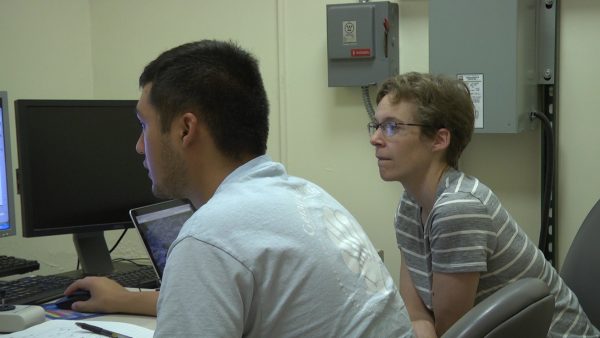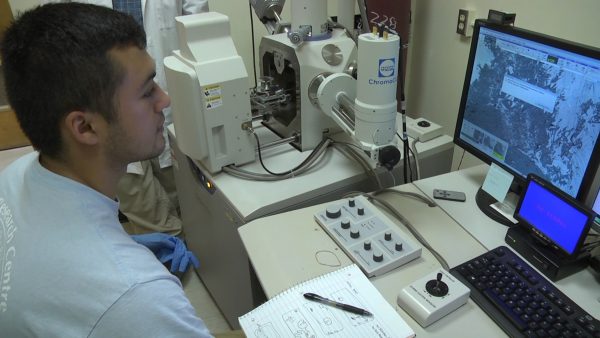Carlos Tellez ’18 got hands-on experience with a scanning electron microscope in a lab at the University of Iowa as part of his Cornell Summer Research Institute project with Cornell College Professor of Geology Emily Walsh.
They used the microscope to get an up-close look at the collections of minerals within their rock samples from the Harcuvar Mountains in western Arizona.
 They worked to estimate the different pressures and temperatures the rocks have experienced over the last 76 million years. The rocks were, at one time, buried deep in the continental crust.
“We can tell from the mineral assemblage where they are actually at—at what depth they are at in the crust or where they came from,” Tellez said. “This can also tell us about the pressure and temperature.”
The pressures and temperatures give the team an idea of how the rock moved through the earth.
Tellez and Walsh also worked with new software to calculate the pressures and temperatures based on the thermodynamic characteristics of the minerals in the rock. They discovered that the Arizona rocks came from deeper within the Earth than previously thought.
“We are learning a lot more about how the Earth works—what our crust is like, what happens at depth, and how it reacts,” Walsh said. “That, then, tells us more about what is going to happen, for example, when two continents collide. It just gives us a better understanding overall of how the structure of the Earth is working.”
Both of them know research opportunities like this are playing a part in Tellez’s overall story.
They worked to estimate the different pressures and temperatures the rocks have experienced over the last 76 million years. The rocks were, at one time, buried deep in the continental crust.
“We can tell from the mineral assemblage where they are actually at—at what depth they are at in the crust or where they came from,” Tellez said. “This can also tell us about the pressure and temperature.”
The pressures and temperatures give the team an idea of how the rock moved through the earth.
Tellez and Walsh also worked with new software to calculate the pressures and temperatures based on the thermodynamic characteristics of the minerals in the rock. They discovered that the Arizona rocks came from deeper within the Earth than previously thought.
“We are learning a lot more about how the Earth works—what our crust is like, what happens at depth, and how it reacts,” Walsh said. “That, then, tells us more about what is going to happen, for example, when two continents collide. It just gives us a better understanding overall of how the structure of the Earth is working.”
Both of them know research opportunities like this are playing a part in Tellez’s overall story.  “CSRI allows the students to get extra experience doing research for a longer period of time,” Walsh said. “In the geology department all students will do at least one Block of research, but spread over 10 weeks, they really get a sense for what research is like and what grad school would be like if they are thinking that direction or not.”
Watch their video story:
“CSRI allows the students to get extra experience doing research for a longer period of time,” Walsh said. “In the geology department all students will do at least one Block of research, but spread over 10 weeks, they really get a sense for what research is like and what grad school would be like if they are thinking that direction or not.”
Watch their video story:
 They worked to estimate the different pressures and temperatures the rocks have experienced over the last 76 million years. The rocks were, at one time, buried deep in the continental crust.
“We can tell from the mineral assemblage where they are actually at—at what depth they are at in the crust or where they came from,” Tellez said. “This can also tell us about the pressure and temperature.”
The pressures and temperatures give the team an idea of how the rock moved through the earth.
Tellez and Walsh also worked with new software to calculate the pressures and temperatures based on the thermodynamic characteristics of the minerals in the rock. They discovered that the Arizona rocks came from deeper within the Earth than previously thought.
“We are learning a lot more about how the Earth works—what our crust is like, what happens at depth, and how it reacts,” Walsh said. “That, then, tells us more about what is going to happen, for example, when two continents collide. It just gives us a better understanding overall of how the structure of the Earth is working.”
Both of them know research opportunities like this are playing a part in Tellez’s overall story.
They worked to estimate the different pressures and temperatures the rocks have experienced over the last 76 million years. The rocks were, at one time, buried deep in the continental crust.
“We can tell from the mineral assemblage where they are actually at—at what depth they are at in the crust or where they came from,” Tellez said. “This can also tell us about the pressure and temperature.”
The pressures and temperatures give the team an idea of how the rock moved through the earth.
Tellez and Walsh also worked with new software to calculate the pressures and temperatures based on the thermodynamic characteristics of the minerals in the rock. They discovered that the Arizona rocks came from deeper within the Earth than previously thought.
“We are learning a lot more about how the Earth works—what our crust is like, what happens at depth, and how it reacts,” Walsh said. “That, then, tells us more about what is going to happen, for example, when two continents collide. It just gives us a better understanding overall of how the structure of the Earth is working.”
Both of them know research opportunities like this are playing a part in Tellez’s overall story.  “CSRI allows the students to get extra experience doing research for a longer period of time,” Walsh said. “In the geology department all students will do at least one Block of research, but spread over 10 weeks, they really get a sense for what research is like and what grad school would be like if they are thinking that direction or not.”
Watch their video story:
“CSRI allows the students to get extra experience doing research for a longer period of time,” Walsh said. “In the geology department all students will do at least one Block of research, but spread over 10 weeks, they really get a sense for what research is like and what grad school would be like if they are thinking that direction or not.”
Watch their video story: